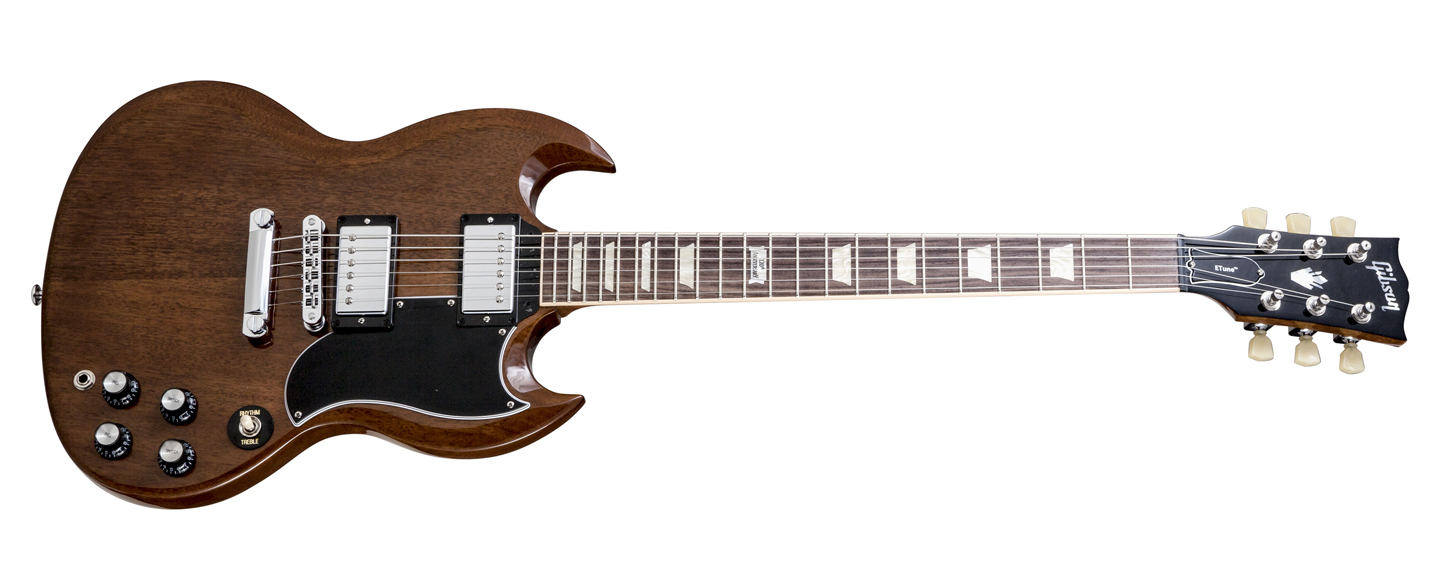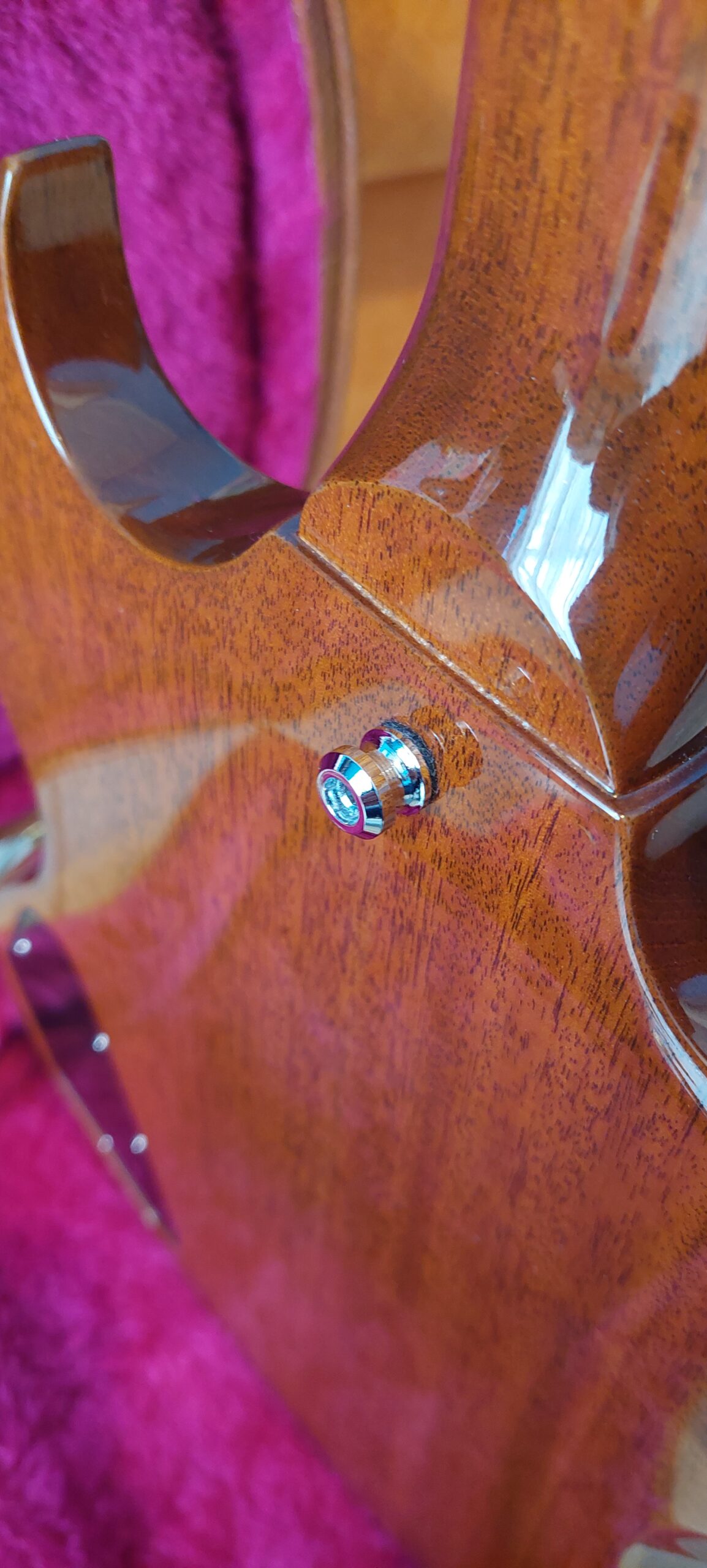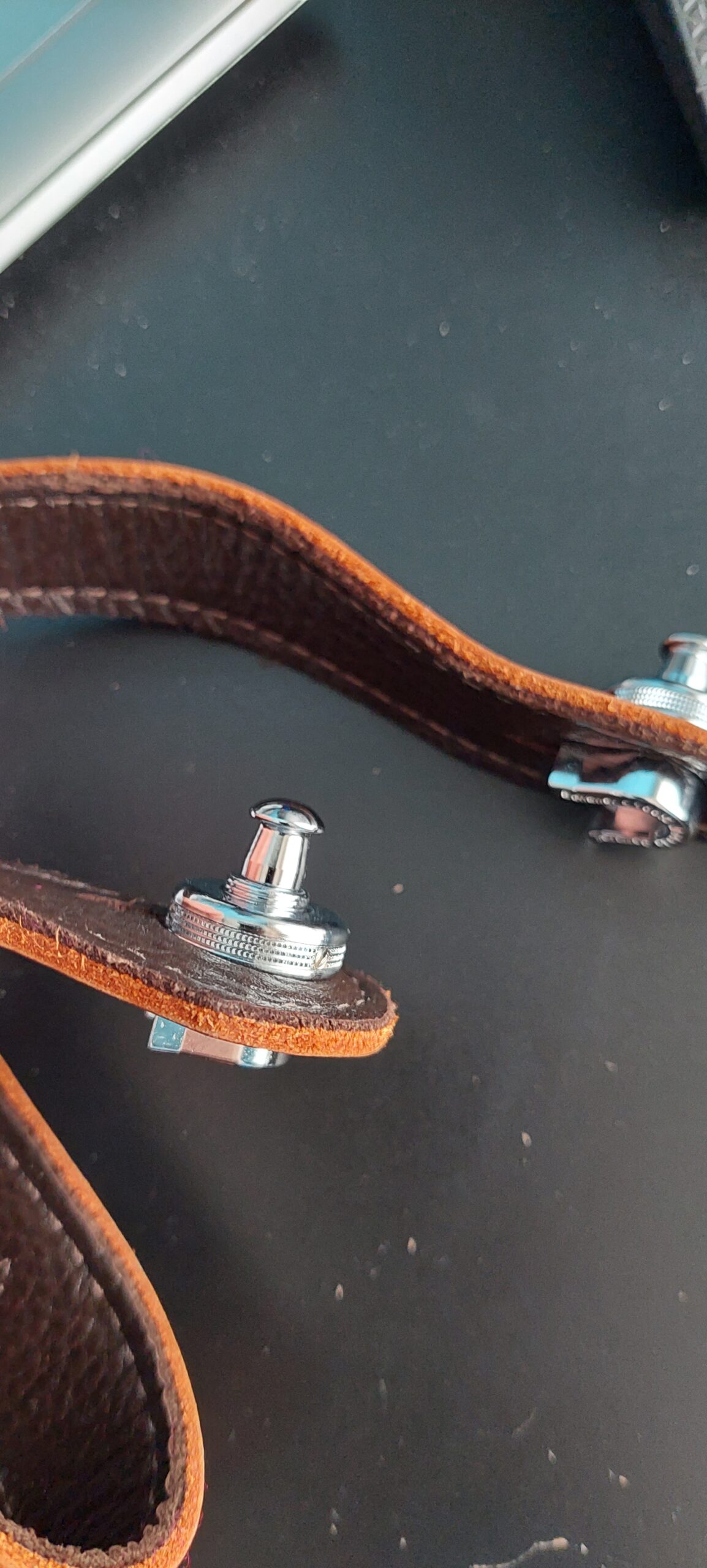Gibson SG Standard 2014 120th Anniversary Review
I've always been an Ibanez fan with, in my opinion, unbeatable value for money, until I bought this Gibson. I will try to make an objective evaluation, with the pros and cons of this guitar.
Let's talk about quality: it's not the top. I have tried many Gibsons before buying this one. I bought it in 2018, after four years on display, unsold. I'm sure the color is the cause. It is not the most requested and appreciated SG color, that is, red. I tried SG standard 2015, 2016, 2017, 2018, they weren't the custom ones, more expensive and cared for, but not even the cheaper versions. I have also tried a few PRS which are definitely of superior overall quality, but no models available impressed me. I also thank the Scavino staff who were very kind and helpful, and allowed me to try many guitars for several days in their well-stocked shop. I also tried many wonderful-sounding Les Pauls, and one in particular struck me, but I found it uncomfortable on the last frets, because it was too chunky at the heel, and it was extremely heavy. There was also a more elaborate version with the heel worked in order to allow easy access to the last frets, but the cost became really impossible for me. In the end, this SG is the only one that really impressed me and, compared to all the other SGs I've tried, the sound was very close to the Les Paul one, although still colder and less full-bodied. The thicker neck and slightly thicker body than newer models gave a fuller, warmer sound. Indeed, the SGs were all profoundly different. Unlike Ibanez, which every guitar produced of the same model (even from different years) is more or less similar to the others, at least in terms of shape, weight and feeling (with the same bridge and pickup), for Gibson they are very different: body more or less thin, neck more or less thin and wide, frets of different thickness, electronics, etc ... I think that this version is one of the most successful Gibson in recent years, such as woods, dimensions and electronics, demonstrating that Gibson (but not only), with the spend of time, it increasingly loses the quality of the productions of the past. I also had the opportunity to try a 2018 Ibanez RG Prestige and I must say that these too suffer from the same problem. Now I understand those who are looking for guitars from the golden years (60 - 80) to be restored, even if, from what is stated in some books that trace the history of guitars, they were not always free from defects. From what I have been able to ascertain, the Gibson 120th Anniversary recall a little the prestige of the past and have been made with better materials and with greater attention than the other vintages.
At the following link you can find the specifications of this guitar:
http://legacy.gibson.com/Products/Electric-Guitars/2014/SG-Standard.aspx
Downsides of this guitar:
- The headstock is oversized, as in all Gibsons. It makes no sense other than aesthetic / historical, apparently, and creates tension problems on the strings at the nut that do not make the strings slide smoothly in the seats. From this point of view Ibanez, Fender, PRS, have well designed palettes compared to Gibson. Plus, on a guitar like the SG, it creates more weight on the neck which tends to move downward. Not a big deal with a good shoulder strap, but I would have completely redesigned it in PRS style.
- The capos are all badly done. I haven't seen an SG or Les Paul with a well made nut. This looks amazing on a guitar that costs and has such a high-sounding name. This guitar, like the others, was born with a poorly made nut, with seats too wide for the coated strings and too thin, almost non-existent, for the other three.
- The button behind the body is uncomfortable and creates an imbalance of the guitar.
- Inaccuracies everywhere, including a small lint under the transparent varnish (it can happen, however ...).
- The Min-ETune cannot tune accurately, but it is still acceptable if you proceed with a single string tuning and set all the parameters correctly.
- The shape, the lower curvature of the body, and the weights make it more uncomfortable to play while seated. In comparison, an Ibanez RG resting on the leg remains perfectly balanced and well centered. Despite everything, this does not compromise the ability to play it at its best.
Advantages:
- It has a wonderful sound. All the wood resonates, the sustain is incredible, from Blues to Rock / Hard Rock, but also a little light Metal, it is always pleasant and the sound envelops and transports you.
- The neck, thicker and fuller than the Ibanez RG, is very pleasant and I had to change my mind: it has absolutely nothing to envy to the Ibanez necks and in some ways I feel it more comfortable. This does not apply to other SGs, as well as Les Paul, because, as I said before, they are very different from each other.
- '57 Alnico 2 pickup, with 2 push / pull volumes and 2 tones. Possibility of splitting the Humbuckers obtaining a really nice Single Coil sound and this makes the guitar very versatile.
- The Min-ETune is comfortable and allows you to switch from one tuning to another very quickly (but it brings with it some negative aspects to take into consideration).
In the end, this guitar, net of its positive and negative sides, is truly excellent, pleasant, versatile, comfortable and with a classic sound that allows you to do a little bit of everything we have learned to appreciate from the 1960s onwards. In this model they decided to put a more full-bodied neck than the others and it feels, and the frets are also an apt size. I don't know what exactly they are, but they seem like medium Jumbo. The Ibanez handles made with layers of wood with different mechanical characteristics expertly combined, are rigid blocks, almost non-deformable. The Gibson, on the other hand, has a neck made from a single piece of mahogany and, compared to the Ibanez, is much more flexible and springy, and this creates a greater sustain and a fuller sound. It cannot be said that one is better than the other. They have different characteristics and purposes.
That said, let's talk about the adverse events and my advice on the fundamental changes to make immediately to the guitar: immediately put the Strap Locks on any SG of any vintage because they fall very easily due to the position of the back button.
Story of a lucky fall
One day, while I was playing the guitar in my house, during a short movement (nothing exaggerated, a slight twist of the torso), the shoulder strap unexpectedly detaches from the rear button and the headstock slams with all its weight on the ground. After the first moments of confusion, synaptic paralysis and terror, I am about to check the state of the guitar. It could have been a lot worse. The angle of the blade hit the electric cable of the pedal power supply which was cut in two, but it incredibly cushioned the fall, causing only a small damage to the corner of the blade and nothing else.
Below are the photos of the damage:
It could have been a lot worse. I consider myself lucky. The guitar has not suffered any damage other than this small aesthetic damage, but at the level of the neck, playability, tightness of the tuning, damage to the heel ... nothing.
But I'm a perfectionist and couldn't look at the guitar with that damage; I understand the yellowing over time, the nitro paint that tends to crack, the natural aging of the guitar, and any little hit here and there, but this damage did not go down on me.
I didn't have a trusted luthier, so I had to rely on the one who inspired me the most, by feeling. In Turin there are many good luthiers, the groups of guitarists I belong to have recommended various professionals and I was very undecided between two or three luthiers who seemed to me to be very competent.
In the end I decided to entrust my guitar to Luca Russo, a luthier from Rivoli (TO), who seemed to me the most suitable for a repair of this type.
At the following link you can know about him:
The repair
I am a person who is apprehensive about the things I care a lot about and I try to do everything myself, but this was not a repair I could do alone and without space. A professional was needed, but before entrusting it to him I had a long interview with him, I met him in person, I saw his workshop, and he proved humble, helpful and kind, always, even when I realized I was a little 'pedantic. I wanted precision work, so as not to touch more than necessary, to keep the originality of the guitar as much as possible, including the paint, for better or for worse. He did just that: precision work. He coated the guitar in order to protect it from scratches and blows during processing (I hope everyone does it, for me it is the minimum), in an extremely effective and safe way. Then he rebuilt the corner with a small piece of mahogany and painted it (sealer, color retouch and clear with nitro varnish).
Here are the photos I took or he sent me during the processing:
Luca was very thorough and careful, he rebuilt the part flawlessly, he researched the color to camouflage the repair as much as possible, until he got a corner that looks almost like new.
On this occasion I asked him to correct the nut, add the Strap Locks and reconfigure the whole guitar, although I have always adjusted everything myself (except the nut) with excellent results. He himself confirmed to me that the guitar was already well tuned.
However, his adjustments have further improved the guitar. His intervention on the nut solved all the tuning problems it had previously. The seats are finally visible (the three uncoated strings had seats just mentioned, almost invisible) and well made, the strings slide well and no longer fit together. In particular, the G and B, which were inevitably forgotten after a bend, now remain perfectly in tune even after extreme bends.
The sound is also improved with a finer adjustment of the Pickups, although in this case the improvements are relative since it depends on the preferences of the listener.
In the end, the work was done precisely and the repair is well done and well camouflaged. The Nitro paint, which has many negative sides, also has the advantage of blending perfectly in the repaired areas, and so it was.
I thank Luca for his patience and his precision in this careful workmanship which has allowed for an almost perfect restoration of the Gibson.
Below, the final photos:
As you can see the mechanics are no longer robotic ones. I didn't have time to take the photos I had to change them. But we will talk about this shortly.
Schaller S-Locks
For those wishing to have information on used Strap Locks, which I recommend to put on immediately, I opted for the new Schaller S-Locks:
I was afraid they were too protruding, especially the rear one, but, instead, they do not create any discomfort. For SG, I recommend buying the Small button directly from the Schaller website (there is no supplier in Italy that sells Schaller buttons of other sizes), which is perfect for the back, while the standard one is fine for the side position.
These are then the buttons used:
The new Schaller S-Locks are really well made and well thought out: they are solid, they do not make noise like the old ones and they are more comfortable to attach. Plus they are much more beautiful. I recommend installing these new Schallers, but I do not recommend using the standard button for the rear of the SG because it is much longer and thicker, so it could cause damage. In any case, the hand of a luthier is not essential for the installation of the Small buttons on the back and Standard (Medium) on the side. On the contrary, putting the standard at the rear certainly requires a more experienced hand.
Min-ETune (G-Force) Gibson – TronicalTune
As you can see from the last photos, I have changed the mechanics. Below I will explain why and what are the advantages and disadvantages of these mechanics.
Advantages:
- For those who are slow or less able to tune the guitar, they are efficient, enough fast and accurate (if single string tuning is used);
- They allow you to change tuning quite quickly;
- It does not require an external tuner.
Disadvantages:
- They require careful calibration, in menus that are not even mentioned in the manual provided by Gibson;
- They are not as precise as skilful manual tuning;
- In my case the E was always slightly increasing, recoverable only manually;
- They move too much and quickly, causing greater and rapid wear of the nut, and not allowing proper stabilization of the strings;
- They are ugly (not an objective judgment, but I don't like them),
- Need a charged battery, although it is possible to tune by hand but with a very uncomfortable ratio, so it takes a long time.
- Very poor materials and very ductile metals.
- The main tuning, the one in which all the strings are played at the same time, is very inaccurate, requires a subsequent intervention for the individual strings and in the end it is inconvenient. Those with a good ear will not appreciate such a rough tuning. I do not recommend using it.
When I first picked up this guitar, I was immediately dismissed by the idea of having that shame on a Gibson.
I therefore tried to please other models. In the end, though, this was the best, the one I had the most feeling with, and I started to see the positives of those robotic mechanics. Once I bought it, I immediately noticed a bit of inefficiency in this system, but I am an Electronic Engineer, so I had to know and understand it thoroughly. I did research, found that the product was from TronicalTune, and, once I found the exact model, I downloaded the complete manual on the official website.
I noticed that depending on the type of strings installed, the behavior was very different: the more the strings sounded full and loud, the more they worked, obviously. So by setting the right level of gain, interference, accuracy, delay and speed of the mechanics, I finally got an excellent result and I started to appreciate the Min-ETune. For those who think the G-Force is very different, I'm sorry to disappoint, but the G-Force is a Min-ETune with a Firmware update and a more catchy name. Although the update may bring improvements, I believe that with the right setting, there is no difference.
Thanks to the Min-ETune and the automatic calibration function, I found that the D'Addario EXL that I have always used on my guitars, resonate much less than others. I did some testing with various brands of strings, but the best ones were the ones I had when I bought the guitar, but I didn't know what they were. After a few phone calls to Scavino, whose staff still proved to be polite, professional and helpful, I narrowed down the possibilities and discovered that they were the Gibson Brite Wires, which I had never tried. Now I use them on all my guitars. With these strings, the Min-ETune was much more efficient, so once I found it, I could appreciate the robotic system at its peak efficiency. However, we must reflect on a very fundamental aspect: are all guitarists able to use this system? No. It depends a lot on how you calibrate it and I don't think everyone is able to do it, especially because changing the type or brand of strings needs a complete recalibration with very different parameters, to obtain an efficient system.
That is why many replace it. I, on the other hand, have decided to replace for other reasons.
Immediately after the repair of the luthier, a few days after retirement, the e string began to no longer maintain the tuning. Passed the note D, he snapped back not allowing you to get up to the e. It was a problem that he had already given before, but rarely and by redoing the tuning he recovered. Instead, from that time on he started to get worse and worse. At first it clicked once or twice and then resumed the tuning correctly, then it started shooting more and more, making tuning very slow and difficult, but above all making the guitar unreliable within a few days.
There were only three solutions:
- Buy a spare powerhead from the TronicalTune website for about 50 euros, including shipping costs;
- Buying a second-hand powerhead;
- Change all the mechanics and put the classic ones, simple and reliable, like the Grover 502C Locking.
I discarded the first solution almost immediately considering that by spending a little more than double, I would have bought the Grover; but above all I thought that this could also happen to the other powerheads, sooner or later.
So I switched to solution two, hoping to find someone who would sell them second-hand, so as to stock up on powerheads, and I found it in a nearby town, so minimum costs and an optimal solution. Unfortunately they put us in Lockdown and I didn't have the opportunity to collect those spare parts, so I decided to move on to solution three: I change everything.
Also because, the battery is lithium, like mobile phones. The average life of a lithium battery is three years, then it depends on how much it is recharged and how. Mine was still good, but sooner or later I would have to change that too. Then I thought even more far-sighted: in 20 or 30 years? It is not possible to think of having a guitar that could have such an addiction to a specific, unique, impossible to find battery among clones, hoping that TronicalTune does not fail and maintain the production of this battery. Not to mention other failures in the electronic part itself.
For those who think they can tune manually with the TronicalTune, I immediately say that it is unthinkable: it has a too uncomfortable and slow ratio.
In the end, among the searches, I found a video that left me no doubt:
The poor and ductile material is not only on the outside, but also inside. That's why they get damaged so easily.
I therefore recommend to those who like the system to buy spare powerheads and a battery as soon as possible, all second-hand, because it is not worth buying new ones, they are very overrated. For those who do not like them, I recommend changing everything as soon as possible, or at the slightest hint of failure.
Grover 502C Locking
So I decided to install Grover 502C Locking tuners, which are already officially used on Gibsons and I got along very well with the mini sisters that I mounted on my Hofner Shorty.
Before mounting them I took the weights to make a comparison:
Full TronicalTune: 266g
Full Grover 502C: 268g
I never would have said: the TronicalTune system, more cumbersome, with larger, thicker mechanics, with the battery and the electronic system, weighs a little less than the Grover, demonstrating that metal materials are not at all up to par. However, it has the advantage of not needing screws and the holes in the headstock are standard.
The installation of the Grover, therefore, was simple, clean, without any sign of the previous presence of the Min-ETune, and did not add additional weight to the headstock, nor did it change the feel of the guitar.
The classical mechanics have improved the tuning, which is now possible to do precisely, and improved its stability, because the fast movement of the TronicalTune does not allow the strings to stabilize correctly, unlike the manual ones, which are not controlled by a program and can be rotated appropriately.
Below, the final photos:
As you can see from the last photos the Gibson paint has decided to betray me in the area below the mechanics of the E and e strings. In a nutshell, the paint had not adhered well to the plastic with which they coated the headstock on the front, and the change of the mechanics obviously created some opening for the air that in a few weeks inflated the paint, yellowing it and finally breaking it. I'll leave it like this for now, after all it's the sign of aging Gibson paint and, from what I see on the internet, it's inevitable. Some like this Relic style. I can't keep up with every sign that may appear in the future and I don't want to compromise its originality.
Now I appreciate this guitar more than before. I still remain of the opinion that the Ibanez Prestige are better made and have a higher quality ratio, but playing this Gibson is something else entirely and it is the sound that makes the difference. So much so that I have decided to change the voice of my Ibanez to see if I can make it more pleasant and versatile. He currently has DiMarzio / Ibz, which are pretty good for metal, but are very cold. I will try to replace them with the more famous Tone Zone, True Velvet, Air Norton, more than anything else because I think the Alnico are more in my strings. Hofner Shorty herself, who now has an Iron Gear Dirty Torque, Alnico 5, has a pleasant sound almost like the Gibson, and it certainly can't be said to be the quality of the wood. I must also admit that with the spend of time, perhaps due to the advancing maturity, my liking for powerful and angry sounds, which I used to appreciate very much, has changed, and now I am more attracted to soft and warm sounds, even if it often returns the desire for High Gain distortions, but always warmer, less sharp.
After replacing the pickups I will be able to make a fairer comparison between Gibson and Ibanez.
I hope this experience and my article can be useful.
Happy guitar to everybody.
Massimo Procopio

























